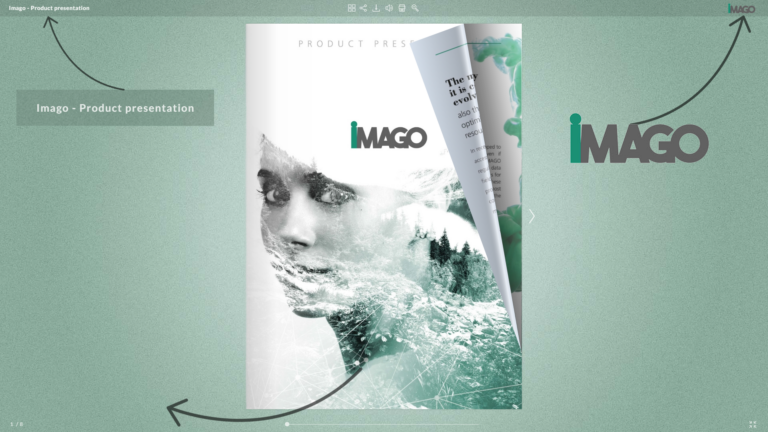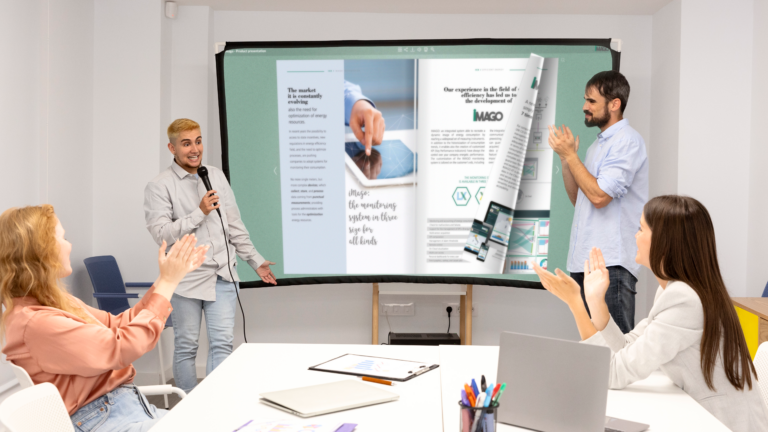Mastering Persuasive Presentation: Engage, Convince, and Inspire
Sure, if you're a beginner, you might think that being good at sales and handling money are the most important business skills. However, being able to get along well with others and communicate effectively is just as important for a successful businessman as making money. That includes not only sharing your ideas using a multimedia presentation but also making a real connection with people – in other words, delivering persuasive presentations.

Giving a persuasive presentation isn’t easy, even for those old hands who’ve done plenty of speaking before. Winning over a room full of skeptical listeners and turning them into enthusiastic fans of your brand demands careful planning and persuasive presentation strategies.
In this guide, we’ll cover everything you need to know to make a successful persuasive speech: crafting a message that resonates with your audience members, mastering presentation delivery techniques, and using Publuu to boost your persuasion skills both online and offline.
Persuasive presentations: What makes them effective?
What is a persuasive presentation?
A persuasive presentation is, simply put, any presentation that persuades. But what does that mean? When you are persuasive, you motivate your audience to take action or believe in an idea. Often, this action is to buy your product, but it can also be to support a cause or make a connection.
The ideal effect of a persuasive presentation is to share your ideas in a way that generates enthusiasm, interest, and a desire to say: “Yes, let's do it!”. To achieve this, you should rely on clear messaging, engaging visuals, and confident speaking to convince people.
SUCCES(s) method
There are many ways to make persuasive presentations that will appeal to your audience. However, at Publuu, we have recently been advocating the SUCCES(s) method, which is described in the popular book Made to Stick by Chip and Dan Heath, and shows how to create stories and presentations that stick (stick stands for 's'). Here is what each element of SUCCES stands for:
◾Simple: Focus on one main key point, and simplify it as much as possible. For example, if you want to portray a software package like Canva, minimize complex terminology, and emphasize that your graphic design software is refreshingly simple and doesn't require a subscription, unlike the competition. Imagine an opening slide with the slogan: "One-time purchase, lifetime access."
◾Unexpected: Surprise your audience with an unexpected statement. Instead of dryly announcing prices and comparing your product with the competition, ask a question that will pique their interest: “What if you had access to professional design tools for a fraction of the price?”
◾Concrete: Illustrate your points with specific, tangible examples. Use real-life comparisons that everyone can understand. Don't just say “no subscription model”; show a comparison table and use real numbers. Highlight the difference between a recurring monthly subscription of €60 and a one-time purchase of €35. Show them basic math: 5 times 12 times 60 is $3600. In five years, that's less than 1% of the total cost, isn't it?

◾Credible: Establish your authority and credibility. Present customer testimonials or highlight awards that your software has won. People often trust their peers more than experts. If you want to deliver a persuasive speech, consider how you can tell others, "I know what I'm talking about."
◾Emotional: Connect with your audience on a deeper level. Consider adding a short video with a customer success story to show the revolutionary impact your software is having on users. Later on, we'll explain how to use various approaches in your persuasive presentation outline.
◾Stories: Base a narrative around your message. Create a story that makes your software a powerful tool available to everyone. People need to identify with the main character in your story or else they'll lose interest. For example, you can tell a story about a freelance artist who bought your software and built his skills up to challenge the professionals.
If you can do that, you can craft persuasive speeches that Stick - that's SUCCES(s)!
Step-by-step guide to creating a persuasive presentation
The SUCCES model provides a clear framework for creating persuasive presentations that appeal to your audience and achieve the desired result. Here's a simple step-by-step guide to building it:
1. Understanding your audience as the first step to persuasive speaking
Start by getting to know the people you want to reach. What are their backgrounds, and interests and what do they want from you? How can your product directly address their needs and priorities? The most important thing is to be specific. Discover their problems and tailor your arguments accordingly.
Imagine you're selling a product to a large corporation. Focus on features that will appeal to high-level decision-makers. Is it extremely user-friendly, even for non-technical teams? By anticipating potential problems, you can take a proactive approach. For example, if your graphics software lacks some features of subscription models, say so! Then flip the scenario: “While we may not have everything, we offer all the essential tools you need for your work, as well as a wider range of features, all at a fraction of the price!”
Consider conducting a SWOT analysis to identify your product's strengths, weaknesses, opportunities, and threats. This exercise will help you develop strategies to address any potential shortcomings.

2. Strengthen your single, unique selling point
Keep it simple. Identify one main message that you want your audience to remember, whether it’s an action you want them to take, a decision to make, or a product/service to consider. Remember that President Clinton won the election with the simple slogan 'It's the economy, stupid.'
Apart from simplicity, focus on clarity in your speech. A well-defined message is easier to understand and provides confidence in its delivery. Imagine your presentation as a clear “yes” or “no” proposition - think about what you want the audience to do, and then guide them in that direction.
3. Create a compelling, emotional content
Use credible, emotional stories as key aspects of the SUCCES(s) model. While facts are crucial, emotions drive actions. Integrate storytelling elements to create an emotional connection with your audience.
Creating engaging presentations can't simply be reduced to showing slides. To deliver a persuasive speech, you need to draw your audience into the story and keep them both logically and emotionally engaged. There are three main ways to persuade others: ethos, pathos, and logos.
1. Ethos: building credibility
To build credibility and present yourself and your ideas as trustworthy, professional design and polished content are essential. With Publuu, you can improve the design of your presentation, making it more professional and credible. Flipbooks from Publuu give your presentation an elegant, consistent look that matches your brand identity or presentation theme. Not only does the presentation resemble an elegant book, but you can also customize the background, icons, or sounds to suit your brand.

2. Pathos: emotionally engaging
Storytelling is a powerful tool for tapping into your audience's emotions. With Publuu, you can bring your stories to life in a unique way, as flipbooks allow you to attach videos or slideshows directly to your flipbook to add a dynamic element to your story. For example, a video of customer feedback can evoke empathy and create a personal connection with your audience.
3. Logos: presenting logical arguments
Presenting logical arguments supported by data and evidence is essential for a compelling presentation. Publuu enhances this by allowing you to display diagrams, charts, and source links directly in your flipbooks. Avoid overwhelming the reader with charts; simply add links to diagrams from market research, financial forecasts or case study results in interactive hotspots. Remember, linking directly to sources or further reading increases the credibility of your arguments. Viewers can explore the data sources themselves, enhancing the sense of transparency and trust.
4. Nurture confidence through practice
Practice your presentation to master the natural rhythm of your speech and ensure smooth transitions between sections. Seek feedback from colleagues. The more naturally you speak, the more credible you are.
Also, remember that your speech should complement the slides. Avoid simply reading them; instead, be dynamic and confident - even if you have to spend several days practicing your persuasive speeches.
5. Accept expected objections
Anticipate potential questions and objections from your audience. Research your topic thoroughly to proactively address these concerns. Prepare concise and confident answers for common objections to strengthen your argument and enhance your credibility. By anticipating potential problems, you build confidence and increase the persuasive power of your presentation.
6. Summarize and conclude strongly
Summarize your key points and reiterate your central message. End with a strong call to action that encourages your audience to take the next step, whether it’s purchasing a product or contacting a sales representative.
7. Use flipbooks from Publuu
Take advantage of innovative presentation forms. Publuu flipbooks not only mimic the traditional form of a book but also allow you to incorporate music, videos, and animations to captivate your audience. Moreover, you can ensure every viewer sees the presentation on their screen and seamlessly integrates it with your educational materials.

Advanced presentation skills: Delivering your message with confidence
When you have a presentation prepared, it's not just about creating a convincing slideshow; it's also about delivering it with confidence to truly impress your audience. Confidence shapes how your target audience perceives you, allowing the presenter to pay attention and look professional.
Practice your speech
Practice your speech multiple times. As we said earlier, getting help from a colleague is beneficial, however, another good option is to record yourself and listen back to identify areas for improvement. Consider whether you sound natural and ensure you're not reading the text off the page like a robot. Speak clearly and confidently, varying your pace and volume to emphasize your speech, and eliminate nervous habits, such as using fillers (“um”, “like”).
Study your body language
You also need to be mindful of your body language. Stand straight, maintain an open posture, and avoid fidgeting. Use natural hand gestures to emphasize points. Try to fit in with the culture and avoid using gestures that might be considered inappropriate.
Stay positive
Above all, you must stay positive in your message. Your emotions need to convey to your audience: don't try to be someone you're not. Speak with genuine conviction, and your message will resonate more deeply. Ensure you are passionate about what you are speaking about.
Leveraging visuals and technology in persuasive presentations
Publuu is a great tool for creating persuasive presentations that use technological solutions and great visuals. It combines the power of PDF technology with the versatility of HTML5 to create captivating presentations that engage your audience.
Write interactive stories with Publuu
Publuu differentiates itself from traditional PDF and PPT presentations by allowing your audience to fully perceive your presentation as a story. With Publuu, you can effortlessly transform your static content into dynamic experiences. Flipbooks from Publuu can include elements such as engaging hotspots that direct your audience to key points, reveal hidden content, or launch captivating animations.
Publuu’s online presentation example
View more online presentation examples
MAKE YOUR OWN
Use animation to deliver the perfect presentation
Captivating animations, slideshows, and animated GIFs can reinforce your message and keep your audience engaged. You can also embed YouTube and Vimeo videos directly into your flipbooks, seamlessly combining visual storytelling with multimedia elements.
Explore the content on your own
Interactive ebooks from Publuu allow your audience to dig into your presentation at their own pace. They can discover new information and insights at their own discretion, which helps build respect among your audience. With the many different viewpoints available in your presentation, you will be perceived as more objective.
Successful persuasive presentations
When it comes to persuasive speech that's both emotional, based on storytelling, and supported by facts and authorities, we can all recommend TED Talks.
TED, which stands for technology, entertainment, and design, is a nonprofit organization that focuses on spreading effective ideas through short, impactful speeches - TED Talks. They organize conferences where experts in various fields present on a variety of topics, all under the motto 'ideas worth spreading'. These talks are filmed and made available for free on the internet, attracting huge audiences worldwide making them perfect examples of persuasive speech. Topics of these talks vary from science to life in foreign countries, but they're always well-conceived. Here are some examples of successful TED Talks:
1. Chimamanda Adichie. The danger of a single-story
In this presentation, the Nigerian writer Chimamanda Adichie challenges cultural assumptions and describes how she learned to express her own culture in her writing. She discusses expanding cultural influence and finding personal meaning.
2. Sir Ken Robinson. Do schools kill creativity?
This very popular speech has circulated online for almost two decades. Watch it to see how Sir Ken Robinson weaves stories into his argument, presenting facts and showing his research, while still being entertaining and to the point.
3. Graham Shaw. Why do people believe they can't draw?
In this presentation example, Graham Shaw not only delivers his speech - he shows it! He uses drawing examples to make his point, remaining persuasive and direct.
Conclusion
Preparing a presentation that will convince and inspire the audience is not so simple. In essence, crafting a persuasive speech boils down to understanding the audience and making them perceive it on the levels of logos, pathos, and ethos.
We recommend using the SUCCES method, which we think provides a valuable framework for creating compelling presentations. By focusing on elements that are Simple, Unexpected, Concrete, Credible, Emotional, and Story-based, you can create narratives that resonate with your audience and leave a lasting impression.
To make your presentation one of a kind, use Publuu! With its interactive capabilities, you can incorporate multimedia elements, create engaging stories, and allow your audience to explore content at their own pace. It's the perfect tool for building credibility, evoking emotion, and presenting logical arguments with supporting evidence.
You may be also interested in:
10 Best Sales Presentations To Inspire Your Sales Deck
10 Types of Presentations with Examples


